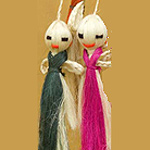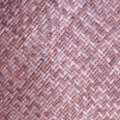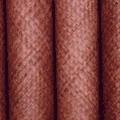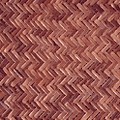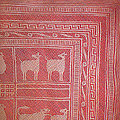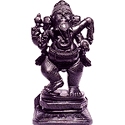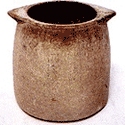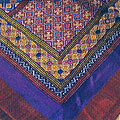Pahari women by tradition wear heavy silver ornaments crafted with sheet metal and wire. Jewellery for the head, ears, arms, neck and forehead is key with a range of designs crafted. The jewellery also usually includes an element of enameling in blue and green. Like across India their dress and jewellery is indicative of their occupation, marital status and community of origin; besides jewellery being an economic investment for rural women. The chili tikka, sirkachamkuli, daman or daonitilak and chak are flat pieces of silver (either enamelled or embedded with pearls)that are worn suspended on the forehead and secured with chains that hang along the hair-line on both sides. The highly intricate nose ornaments nath or balu and the septum ornaments bulak or kundu that are worn only by married women. Necklaces include the torque- like sira or hansli to the small pendants or the toke. While many distinct bead neck-laces-kamrakhi mala, dodmala, jau mala, dar mala made of beads of various shapes and forms are linked together by silver plaques. Of these, the chandanhaar or chandrasanihaar, constructed of five or seven rows of facetted gold beads, is perhaps the most popular. These elaborate necklaces of several large and small die-stamped pendants are linked together by odd-numbered chains. Silver amulets are worn across Himachal by men, women and children as it is believed that they have the power to ward off evil spirits. Bagles, ornaments for the feet - toe rings, anklets are all commonly worn The designs, inspired by nature include the peepal leaves, other leaf forms, magnolia-bud, seeds, flowers and peacocks, snakes and the crescent moon. Silver or gold tassels are added n hair ornaments The craftsmen additionally make brass mohra, masks of deities. The tools are basic and include the tweezer, pliers, cutter, the klenti - the tool used to measure the diameter of rings, hammer and blow pipe.
Pahari women by tradition wear heavy silver ornaments crafted with sheet metal and wire. Jewellery for the head, ears, arms, neck and forehead is key with a range of designs crafted. The jewellery also usually includes an element of enameling in blue and green. Like across India their dress and jewellery is indicative of their occupation, marital status and community of origin; besides jewellery being an economic investment for rural women. The chili tikka, sirkachamkuli, daman or daonitilak and chak are flat pieces of silver (either enamelled or embedded with pearls)that are worn suspended on the forehead and secured with chains that hang along the hair-line on both sides. The highly intricate nose ornaments nath or balu and the septum ornaments bulak or kundu that are worn only by married women. Necklaces include the torque- like sira or hansli to the small pendants or the toke. While many distinct bead neck-laces-kamrakhi mala, dodmala, jau mala, dar mala made of beads of various shapes and forms are linked together by silver plaques. Of these, the chandanhaar or chandrasanihaar, constructed of five or seven rows of facetted gold beads, is perhaps the most popular. These elaborate necklaces of several large and small die-stamped pendants are linked together by odd-numbered chains. Silver amulets are worn across Himachal by men, women and children as it is believed that they have the power to ward off evil spirits. Bagles, ornaments for the feet - toe rings, anklets are all commonly worn. The designs, inspired by nature include the peepal leaves, other leaf forms, magnolia-bud, seeds, flowers and peacocks, snakes and the crescent moon. Silver or gold tassels are added n hair ornaments. The craftsmen additionally make brass mohra, masks of deities. The tools are basic and include the tweezer, pliers, cutter, the klenti - the tool used to measure the diameter of rings, hammer and blow pipe.
Lucknow is famous for its silver work in which he artisans do embossing, engraving and openwork altogether on sheet silver to create utensils, bridal footwear and paandaans. Craft items such as anklets with bells/paizeb, earrings/jhumkas, pots/lota, cups/katora, ritual pots/matki, glasses and plates, slippers, amulet/tabiz, inkpot/dawait, pen/kalam are created by the silversmiths. Tools such as file/reti, tongs/chimti, pliers/plas, iron square/nehai, wooden die/dari, ball-ended punch/khalna, cast/reza, chisels/kalam, hammer/hathodi, copperwire brush/katarni, die/sandaan, metal die/thappa, iron plate/jantari are used for the crafting process.
The strength of this plant is reflected in its local name of hattibar, or 'elephant fence. A member of the sisal (Agave) family, this is a perennial plant, which stands 1-2 m high. The fibre is extracted from the mature outer leaves that are cut. The fibres are extracted by retting and beating. The sisal is basically used for ropes and for the weaving of porters' headbands.
Sisal plant is abundantly grown in the region of Chhattisgarh. When the sisal leaves are processed they produce very fine white fibre. This fibre though very smooth to touch has excellent tensile strength. Sisal fibre is durable and resistant to moisture and hence a favourable for products used at home for daily purpose. These fibres have been very popularly used in making decorative products and items of utility. Some items include bottle holder, key rings, key chains, ropes for boats and ships, wall hangings, mats, coasters and dolls. With aesthetically pleasing texture sisal products have gained popularity in the modern markets.
Sisal fibre products are tougher than jute and are crafted into attractive and colourful bags and mats.
Mat-weaving as an art form is traced back to ancient times in India, with sages traditionally being depicted as meditating seated on woven mats, as indicated by an old Bengali proverb, as well as by texts in the Vedic corpus of religious texts. The craft - both mat-weaving and basketry - is described by Kamladevi Chatopadhyaya as 'interlacing' two or more strands of the material (reeds, leaves, rushes, cane, bamboo, palm leaves) in different ways, a description that bespeaks an inherent simplicity, but still hints at the poetry of weaving mats and baskets from strips of reeds and leaves.
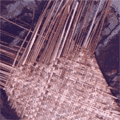 The craft of mat-weaving is basically a utilitarian rural tradition to create items of everyday use from the raw materials available in profuse quantities in the sub-tropical marshy and wet regions of West Bengal. Mats for sitting on and sleeping on, baskets for carrying and storage, and hand-fans for helping endure the heat are a few of the common products that are made. Different kinds of mats and baskets are made in different areas of West Bengal, depending on the particular reed or grass that is easily available, the weaving traditions specific to an area, and the needs of the local populace.
Well-known (perhaps the most well-known) among the various mats from West Bengal is the sitalpati mat, made from green cane slips of the Maranta dichotoma which are split into very fine slices length wise. This mat is another exposition of the skill of 'joining grass with grass and interlacing leaves' to weave an item that is comfortable, utilitarian and beautiful. The quality of the sitalpati mat is judged by its glossiness, smoothness and fineness of texture. It is said that the best kind of sitalpati is so smooth that even a snake cannot glide over it. The word sital or sheetal means cool and the sitalpati mat is famous for the feeling of cool it imparts to the person sitting or sleeping on it. This particular quality of the sitalpati is particularly apt for the warm and humid climate of West Bengal. Mats in general - and sitalpati mats in particular - although defined primarily as a rural craft, linked intimately with everyday life are, however, now available outside of the hinterlands of West Bengal; the aesthetic appeal and utilitarian value of these mats have made them increasingly visible in large towns and metropolitan cities, that is, outside of their traditional market.
The sitalpati mat is made in the northern Cooch Behar district of West Bengal (as well as in the neighbouring states of Tripura and Assam; and in Bangladesh, which was East Bengal in an undivided subcontinent). In West Bengal it is woven dominantly by members of the kayastha caste. (The kayasthas rank below the brahmins but above the mahisyas who weave the popular and less expensive madur mats, with the production concentrated in Midnapore district of East Bengal.) Among the areas in Cooch Behar where sitalpati mats are woven, Sagareswar Ghugumari and Pashnadanga are important centres.
The craft of mat-weaving is basically a utilitarian rural tradition to create items of everyday use from the raw materials available in profuse quantities in the sub-tropical marshy and wet regions of West Bengal. Mats for sitting on and sleeping on, baskets for carrying and storage, and hand-fans for helping endure the heat are a few of the common products that are made. Different kinds of mats and baskets are made in different areas of West Bengal, depending on the particular reed or grass that is easily available, the weaving traditions specific to an area, and the needs of the local populace.
Well-known (perhaps the most well-known) among the various mats from West Bengal is the sitalpati mat, made from green cane slips of the Maranta dichotoma which are split into very fine slices length wise. This mat is another exposition of the skill of 'joining grass with grass and interlacing leaves' to weave an item that is comfortable, utilitarian and beautiful. The quality of the sitalpati mat is judged by its glossiness, smoothness and fineness of texture. It is said that the best kind of sitalpati is so smooth that even a snake cannot glide over it. The word sital or sheetal means cool and the sitalpati mat is famous for the feeling of cool it imparts to the person sitting or sleeping on it. This particular quality of the sitalpati is particularly apt for the warm and humid climate of West Bengal. Mats in general - and sitalpati mats in particular - although defined primarily as a rural craft, linked intimately with everyday life are, however, now available outside of the hinterlands of West Bengal; the aesthetic appeal and utilitarian value of these mats have made them increasingly visible in large towns and metropolitan cities, that is, outside of their traditional market.
The sitalpati mat is made in the northern Cooch Behar district of West Bengal (as well as in the neighbouring states of Tripura and Assam; and in Bangladesh, which was East Bengal in an undivided subcontinent). In West Bengal it is woven dominantly by members of the kayastha caste. (The kayasthas rank below the brahmins but above the mahisyas who weave the popular and less expensive madur mats, with the production concentrated in Midnapore district of East Bengal.) Among the areas in Cooch Behar where sitalpati mats are woven, Sagareswar Ghugumari and Pashnadanga are important centres.
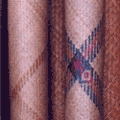 A minimum of tools are used to weave these mats; the critical techniques involve the creation of thin, smooth and pliable strips, and the comfort and aesthetic appeal are determined by the weaver's skill, weaving action, and innovativeness with weave and colour. There are few set rules about deigns and patterns but coloured motifs are usually created in bands along the edges only. Coloured motifs and patterns are created by weaving a colour dyed weft with a natural cream-brown warp. The extra weft technique is used for creating stylised human, animal and leaf motifs.
A minimum of tools are used to weave these mats; the critical techniques involve the creation of thin, smooth and pliable strips, and the comfort and aesthetic appeal are determined by the weaver's skill, weaving action, and innovativeness with weave and colour. There are few set rules about deigns and patterns but coloured motifs are usually created in bands along the edges only. Coloured motifs and patterns are created by weaving a colour dyed weft with a natural cream-brown warp. The extra weft technique is used for creating stylised human, animal and leaf motifs.
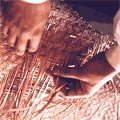 The making of sitalpati mats has been adopted as a profession by entire families. According to Pradeep Das' estimate, about 50,000 people in the district of Cooch Behar pursue sitalpati mat-weaving as a livelihood, with the entire family participating in the work and helping in whichever part of the process they are most adept at. Pradeep Das states that a mat that is 4 feet by six feet takes about a day and a half to weave, the wetting, drying and dyeing process being separate.
The making of sitalpati mats has been adopted as a profession by entire families. According to Pradeep Das' estimate, about 50,000 people in the district of Cooch Behar pursue sitalpati mat-weaving as a livelihood, with the entire family participating in the work and helping in whichever part of the process they are most adept at. Pradeep Das states that a mat that is 4 feet by six feet takes about a day and a half to weave, the wetting, drying and dyeing process being separate.
Mat-weaving as an art form is traced back to ancient times in India, with sages traditionally being depicted as meditating seated on woven mats, as indicated by an old Bengali proverb, as well as by texts in the Vedic corpus of religious texts. The craft - both mat-weaving and basketry - is described by Kamladevi Chatopadhyaya as 'interlacing' two or more strands of the material (reeds, leaves, rushes, cane, bamboo, palm leaves) in different ways, a description that bespeaks an inherent simplicity, but still hints at the poetry of weaving mats and baskets from strips of reeds and leaves.
 The craft of mat-weaving is basically a utilitarian rural tradition to create items of everyday use from the raw materials available in profuse quantities in the sub-tropical marshy and wet regions of West Bengal. Mats for sitting on and sleeping on, baskets for carrying and storage, and hand-fans for helping endure the heat are a few of the common products that are made. Different kinds of mats and baskets are made in different areas of West Bengal, depending on the particular reed or grass that is easily available, the weaving traditions specific to an area, and the needs of the local populace.
Well-known (perhaps the most well-known) among the various mats from West Bengal is the sitalpati mat, made from green cane slips of the Maranta dichotoma which are split into very fine slices length wise. This mat is another exposition of the skill of 'joining grass with grass and interlacing leaves' to weave an item that is comfortable, utilitarian and beautiful. The quality of the sitalpati mat is judged by its glossiness, smoothness and fineness of texture. It is said that the best kind of sitalpati is so smooth that even a snake cannot glide over it. The word sital or sheetal means cool and the sitalpati mat is famous for the feeling of cool it imparts to the person sitting or sleeping on it. This particular quality of the sitalpati is particularly apt for the warm and humid climate of West Bengal. Mats in general - and sitalpati mats in particular - although defined primarily as a rural craft, linked intimately with everyday life are, however, now available outside of the hinterlands of West Bengal; the aesthetic appeal and utilitarian value of these mats have made them increasingly visible in large towns and metropolitan cities, that is, outside of their traditional market.
The sitalpati mat is made in the northern Cooch Behar district of West Bengal (as well as in the neighbouring states of Tripura and Assam; and in Bangladesh, which was East Bengal in an undivided subcontinent). In West Bengal it is woven dominantly by members of the kayastha caste. (The kayasthas rank below the brahmins but above the mahisyas who weave the popular and less expensive madur mats, with the production concentrated in Midnapore district of East Bengal.) Among the areas in Cooch Behar where sitalpati mats are woven, Sagareswar Ghugumari and Pashnadanga are important centres.
The craft of mat-weaving is basically a utilitarian rural tradition to create items of everyday use from the raw materials available in profuse quantities in the sub-tropical marshy and wet regions of West Bengal. Mats for sitting on and sleeping on, baskets for carrying and storage, and hand-fans for helping endure the heat are a few of the common products that are made. Different kinds of mats and baskets are made in different areas of West Bengal, depending on the particular reed or grass that is easily available, the weaving traditions specific to an area, and the needs of the local populace.
Well-known (perhaps the most well-known) among the various mats from West Bengal is the sitalpati mat, made from green cane slips of the Maranta dichotoma which are split into very fine slices length wise. This mat is another exposition of the skill of 'joining grass with grass and interlacing leaves' to weave an item that is comfortable, utilitarian and beautiful. The quality of the sitalpati mat is judged by its glossiness, smoothness and fineness of texture. It is said that the best kind of sitalpati is so smooth that even a snake cannot glide over it. The word sital or sheetal means cool and the sitalpati mat is famous for the feeling of cool it imparts to the person sitting or sleeping on it. This particular quality of the sitalpati is particularly apt for the warm and humid climate of West Bengal. Mats in general - and sitalpati mats in particular - although defined primarily as a rural craft, linked intimately with everyday life are, however, now available outside of the hinterlands of West Bengal; the aesthetic appeal and utilitarian value of these mats have made them increasingly visible in large towns and metropolitan cities, that is, outside of their traditional market.
The sitalpati mat is made in the northern Cooch Behar district of West Bengal (as well as in the neighbouring states of Tripura and Assam; and in Bangladesh, which was East Bengal in an undivided subcontinent). In West Bengal it is woven dominantly by members of the kayastha caste. (The kayasthas rank below the brahmins but above the mahisyas who weave the popular and less expensive madur mats, with the production concentrated in Midnapore district of East Bengal.) Among the areas in Cooch Behar where sitalpati mats are woven, Sagareswar Ghugumari and Pashnadanga are important centres.
 A minimum of tools are used to weave these mats; the critical techniques involve the creation of thin, smooth and pliable strips, and the comfort and aesthetic appeal are determined by the weaver's skill, weaving action, and innovativeness with weave and colour. There are few set rules about deigns and patterns but coloured motifs are usually created in bands along the edges only. Coloured motifs and patterns are created by weaving a colour dyed weft with a natural cream-brown warp. The extra weft technique is used for creating stylised human, animal and leaf motifs.
A minimum of tools are used to weave these mats; the critical techniques involve the creation of thin, smooth and pliable strips, and the comfort and aesthetic appeal are determined by the weaver's skill, weaving action, and innovativeness with weave and colour. There are few set rules about deigns and patterns but coloured motifs are usually created in bands along the edges only. Coloured motifs and patterns are created by weaving a colour dyed weft with a natural cream-brown warp. The extra weft technique is used for creating stylised human, animal and leaf motifs.
 The making of sitalpati mats has been adopted as a profession by entire families. According to Pradeep Das' estimate, about 50,000 people in the district of Cooch Behar pursue sitalpati mat-weaving as a livelihood, with the entire family participating in the work and helping in whichever part of the process they are most adept at. Pradeep Das states that a mat that is 4 feet by six feet takes about a day and a half to weave, the wetting, drying and dyeing process being separate.
The making of sitalpati mats has been adopted as a profession by entire families. According to Pradeep Das' estimate, about 50,000 people in the district of Cooch Behar pursue sitalpati mat-weaving as a livelihood, with the entire family participating in the work and helping in whichever part of the process they are most adept at. Pradeep Das states that a mat that is 4 feet by six feet takes about a day and a half to weave, the wetting, drying and dyeing process being separate.
Mat-weaving as an art form is traced back to ancient times in India, with sages traditionally being depicted as meditating seated on woven mats, as indicated by an old Bengali proverb, as well as by texts in the Vedic corpus of religious texts. The craft - both mat-weaving and basketry - is described by Kamladevi Chatopadhyaya as 'interlacing' two or more strands of the material (reeds, leaves, rushes, cane, bamboo, palm leaves) in different ways, a description that bespeaks an inherent simplicity, but still hints at the poetry of weaving mats and baskets from strips of reeds and leaves.
 The craft of mat-weaving is basically a utilitarian rural tradition to create items of everyday use from the raw materials available in profuse quantities in the sub-tropical marshy and wet regions of West Bengal. Mats for sitting on and sleeping on, baskets for carrying and storage, and hand-fans for helping endure the heat are a few of the common products that are made. Different kinds of mats and baskets are made in different areas of West Bengal, depending on the particular reed or grass that is easily available, the weaving traditions specific to an area, and the needs of the local populace.
Well-known (perhaps the most well-known) among the various mats from West Bengal is the sitalpati mat, made from green cane slips of the Maranta dichotoma which are split into very fine slices length wise. This mat is another exposition of the skill of 'joining grass with grass and interlacing leaves' to weave an item that is comfortable, utilitarian and beautiful. The quality of the sitalpati mat is judged by its glossiness, smoothness and fineness of texture. It is said that the best kind of sitalpati is so smooth that even a snake cannot glide over it. The word sital or sheetal means cool and the sitalpati mat is famous for the feeling of cool it imparts to the person sitting or sleeping on it. This particular quality of the sitalpati is particularly apt for the warm and humid climate of West Bengal. Mats in general - and sitalpati mats in particular - although defined primarily as a rural craft, linked intimately with everyday life are, however, now available outside of the hinterlands of West Bengal; the aesthetic appeal and utilitarian value of these mats have made them increasingly visible in large towns and metropolitan cities, that is, outside of their traditional market.
The sitalpati mat is made in the northern Cooch Behar district of West Bengal (as well as in the neighbouring states of Tripura and Assam; and in Bangladesh, which was East Bengal in an undivided subcontinent). In West Bengal it is woven dominantly by members of the kayastha caste. (The kayasthas rank below the brahmins but above the mahisyas who weave the popular and less expensive madur mats, with the production concentrated in Midnapore district of East Bengal.) Among the areas in Cooch Behar where sitalpati mats are woven, Sagareswar Ghugumari and Pashnadanga are important centres.
The craft of mat-weaving is basically a utilitarian rural tradition to create items of everyday use from the raw materials available in profuse quantities in the sub-tropical marshy and wet regions of West Bengal. Mats for sitting on and sleeping on, baskets for carrying and storage, and hand-fans for helping endure the heat are a few of the common products that are made. Different kinds of mats and baskets are made in different areas of West Bengal, depending on the particular reed or grass that is easily available, the weaving traditions specific to an area, and the needs of the local populace.
Well-known (perhaps the most well-known) among the various mats from West Bengal is the sitalpati mat, made from green cane slips of the Maranta dichotoma which are split into very fine slices length wise. This mat is another exposition of the skill of 'joining grass with grass and interlacing leaves' to weave an item that is comfortable, utilitarian and beautiful. The quality of the sitalpati mat is judged by its glossiness, smoothness and fineness of texture. It is said that the best kind of sitalpati is so smooth that even a snake cannot glide over it. The word sital or sheetal means cool and the sitalpati mat is famous for the feeling of cool it imparts to the person sitting or sleeping on it. This particular quality of the sitalpati is particularly apt for the warm and humid climate of West Bengal. Mats in general - and sitalpati mats in particular - although defined primarily as a rural craft, linked intimately with everyday life are, however, now available outside of the hinterlands of West Bengal; the aesthetic appeal and utilitarian value of these mats have made them increasingly visible in large towns and metropolitan cities, that is, outside of their traditional market.
The sitalpati mat is made in the northern Cooch Behar district of West Bengal (as well as in the neighbouring states of Tripura and Assam; and in Bangladesh, which was East Bengal in an undivided subcontinent). In West Bengal it is woven dominantly by members of the kayastha caste. (The kayasthas rank below the brahmins but above the mahisyas who weave the popular and less expensive madur mats, with the production concentrated in Midnapore district of East Bengal.) Among the areas in Cooch Behar where sitalpati mats are woven, Sagareswar Ghugumari and Pashnadanga are important centres.
 A minimum of tools are used to weave these mats; the critical techniques involve the creation of thin, smooth and pliable strips, and the comfort and aesthetic appeal are determined by the weaver's skill, weaving action, and innovativeness with weave and colour. There are few set rules about deigns and patterns but coloured motifs are usually created in bands along the edges only. Coloured motifs and patterns are created by weaving a colour dyed weft with a natural cream-brown warp. The extra weft technique is used for creating stylised human, animal and leaf motifs.
A minimum of tools are used to weave these mats; the critical techniques involve the creation of thin, smooth and pliable strips, and the comfort and aesthetic appeal are determined by the weaver's skill, weaving action, and innovativeness with weave and colour. There are few set rules about deigns and patterns but coloured motifs are usually created in bands along the edges only. Coloured motifs and patterns are created by weaving a colour dyed weft with a natural cream-brown warp. The extra weft technique is used for creating stylised human, animal and leaf motifs.
 The making of sitalpati mats has been adopted as a profession by entire families. According to Pradeep Das' estimate, about 50,000 people in the district of Cooch Behar pursue sitalpati mat-weaving as a livelihood, with the entire family participating in the work and helping in whichever part of the process they are most adept at. Pradeep Das states that a mat that is 4 feet by six feet takes about a day and a half to weave, the wetting, drying and dyeing process being separate.
The making of sitalpati mats has been adopted as a profession by entire families. According to Pradeep Das' estimate, about 50,000 people in the district of Cooch Behar pursue sitalpati mat-weaving as a livelihood, with the entire family participating in the work and helping in whichever part of the process they are most adept at. Pradeep Das states that a mat that is 4 feet by six feet takes about a day and a half to weave, the wetting, drying and dyeing process being separate.
Mat-weaving as an art form is traced back to ancient times in India, with sages traditionally being depicted as meditating seated on woven mats, as indicated by an old Bengali proverb, as well as by texts in the Vedic corpus of religious texts. The craft - both mat-weaving and basketry - is described by Kamladevi Chatopadhyaya as 'interlacing' two or more strands of the material (reeds, leaves, rushes, cane, bamboo, palm leaves) in different ways, a description that bespeaks an inherent simplicity, but still hints at the poetry of weaving mats and baskets from strips of reeds and leaves.
The craft of mat-weaving is basically a utilitarian rural tradition to create items of everyday use from the raw materials available in profuse quantities in the sub-tropical marshy and wet regions of West Bengal. Mats for sitting on and sleeping on, baskets for carrying and storage, and hand-fans for helping endure the heat are a few of the common products that are made. Different kinds of mats and baskets are made in different areas of West Bengal, depending on the particular reed or grass that is easily available, the weaving traditions specific to an area, and the needs of the local populace.
Well-known (perhaps the most well-known) among the various mats from West Bengal is the sitalpati mat, made from green cane slips of the Maranta dichotoma which are split into very fine slices length wise. This mat is another exposition of the skill of 'joining grass with grass and interlacing leaves' to weave an item that is comfortable, utilitarian and beautiful. The quality of the sitalpati mat is judged by its glossiness, smoothness and fineness of texture. It is said that the best kind of sitalpati is so smooth that even a snake cannot glide over it. The word sital or sheetal means cool and the sitalpati mat is famous for the feeling of cool it imparts to the person sitting or sleeping on it. This particular quality of the sitalpati is particularly apt for the warm and humid climate of West Bengal. Mats in general - and sitalpati mats in particular - although defined primarily as a rural craft, linked intimately with everyday life are, however, now available outside of the hinterlands of West Bengal; the aesthetic appeal and utilitarian value of these mats have made them increasingly visible in large towns and metropolitan cities, that is, outside of their traditional market. The sitalpati mat is made in the northern Cooch Behar district of West Bengal (as well as in the neighbouring states of Tripura and Assam; and in Bangladesh, which was East Bengal in an undivided subcontinent). In West Bengal it is woven dominantly by members of the kayastha caste. (The kayasthas rank below the brahmins but above the mahisyas who weave the popular and less expensive madur mats, with the production concentrated in Midnapore district of East Bengal.) Among the areas in Cooch Behar where sitalpati mats are woven, Sagareswar Ghugumari and Pashnadanga are important centres.Sitalpati, literally cool mats are popular, aesthetic in design, luxurious in their feel and more expensive than other mats made from reeds and natural fibres. Sitalpati mats are crafted from the marantra dichotoma or mutra reed and it use is ubiquitous – from sleeping to sitting on, as a floor mat and a prayer mat and as a wall hanging. A relatively new design development has been the use of sitalpati mat cuttings as an embellishment on bags of all varieties, on pen stands and other table top items. Exceptionally well suited to the warm humid climate of Bangladesh these mats are as prized for their comfort as for their exceptional beauty. It is said that the best type of sitalpati mat is so silky that a snake cannot move across it as its smoothness allows no friction to the wriggling body of the reptile, without which it can make no progress.
Soapstone is used mainly for shaping and carving idols; there are many villages in Bastar which have shrines with stone idols. The villages of Bade Dongar, Chotta Dongar, Dantewada, Narangpal, Bastar, Kondagaon, Chapka and Amravati are well-known for their stone shrines (dev-gudi). The idols made are of Budhi Mai, Danteshwai, Khanda Kanalin, Phiranta Mata, Jhitku-Mitki, Banga Ram, Andhar Devi, Sendia Mata, Mavli Devi and Rao Dev --- these being some of the most important gods and goddesses worshipped by the tribals, particularly by the Muria, Mahara and Rawat communities. These deities are believed to protect the village from evil forces and diseases. Non-ritualistic products like a Mariamaak, as well as paper-weights and pin-stands are also crafted out or soapstone. The large tool used for cutting stone is called as basula, and the chisels (of various shapes and sizes ) used for fine carving are known as pataasis. The Whar make free-hand carvings with these chisels, enlivening the basic motifs with details. The other tools used are guniya, a compass for measurement, and a chisel with a slight depression which is used to make grooves. The two types of impressions made by this chisel are warja --- where the blade is broad --- and warji --- where the blade is narrow. The idols are polished with polishing stones or battas by women and children. There are five types of stones available at Banaur of which rajouri is the most durable. The stone most suitable for carving idols is dingi, and another type of stone known as dauver is used for making lattices. A pink and white stone called sudapaal is found in Bastar. This is quite soft and easily carved. The two types of idols that are made are the tatiya saaj --- which has two-dimensional relief work --- and the akshang --- with three-dimensional relief work. In parts of western Madhya Pradesh, idols of the gods Hanuman, Ganesh and Shiva, and the goddess Parvati are carved by the Meena, Gujarat and Raigarh tribals, who are mainly from Rajasthan; the idols of the gods Pabuji and Tejaji of Rajasthan are also carved. These are found in the districts of Ratlam, Kurkshi and Mandsaur. The popular deities that are stone-crafted include the gods Bijasan, Bhairav, Hardaul, Karas Deo and Hanuman, and the goddesses, Durga, Kali and Bhawani. In Kailaven and Tikamgarh districts, figures of wild animals are also carved.
Soapstone figures are extremely popular in Tamil Nadu, and are sold in pilgrimage and tourist centres. The figures are small, usually about half a metre in height. Soapstone is soft and pliable and is cut with a hand-saw and chiselled with simple tools.
Utilitarian stoneware of the highest excellence is made in Salem district and in the region between Pondicherry and Cudallore in Tamil Nadu. The items made are vessels for storage, serving dishes, mortar and pestle, bowls and ornamented single-wick lamps. These items are made with the use of hammer and chisel and are turned on the lathe. Utensils made of soapstone, which is a soft light gray colour with a cool smooth texture, are perfectly suited to store buttermilk, milk and curds. It is also the preferred vessel for cooking food that uses tamarind and lime.
Soapstone figures are small, usually about half a metre in height. Soapstone is soft and pliable and is cut with a hand-saw and chiselled with simple tools.
Solapuri Chaddar is a cotton bedcover woven in Solapur city in Maharashtra. It is known for its special design and durability. The design is spread all over the body of the fabric and it is developed with the extra warp technique. Multicoloured extra warp yarns are frequently used to decorate the fabric. It is woven with coarser cotton yarns in both the warp and weft. In the heading, name of the manufacturer is woven.
Solapur Terry Towels are manufactured in the Solapur district of Maharashtra. This woven or knitted towel has been protected under the GI act. The Solapur Terry Towel has unique designs and is much in demand all over the world.
Embroidery from the Saurashtra and Kutch regions in Gujarat is extremely versatile. One of the oldest embroidery forms is the kathi. The themes range from tales of romance and heroism to religious motifs. Ganesh is embroidered on small squares of fabric which are then worshipped. Heer is an embossed stitch which derives its name from the soft silk found locally. Light and shadow create clever illusions of variations in colour. The colours used include madder red, black, off-white, indigo, ivory, yellow, and green. Mirrors are also used for embellishment. Adiya fatiya is a stitch which automatically brightens up a fabric. Multicoloured fabric pieces are used to produce patchwork items that are widely coveted. The designs are mainly geometrical. Abhala is the mirror embroidery where small round pieces of mirror are fixed on to the fabric by buttonhole stitching; the embroidery is done in a stem or herringbone stitch with silken thread. The colour blends include rust and deep red, light green and pink, and purple and indigo blue. This embroidery is practised mainly by the kanbi community. This community also decorates homes with elaborate embroidery pieces. The other items embellished with this combination of mirror work and embroidery are head cloths, skirts, and richly embroidered kanjris or blouses. The embroidery from Kutch is known as aribharat or ari. This is made from silk threads using a hook. The stitch is also called mochibharat. The ari embroidery is usually done on locally available satin gajji cloth. The motifs found commonly are bootis, flowering bushes, dancing peacocks, and human figures in dancing poses. The kanbibharat is done with cotton thread with darning and herring-bone stitches. The colours used are saffron, yellow, white, purple, and green. Adornments for domestic animals, covers for wooden chests called pataras, and quilts are made commonly. The embroidery of the Rabari community is usually done on a maroon background and the motifs are enclosed in a circle with an arrangement of mirror bootis. Coloured threads and mirrors are used. Cotton and quality silks are used by jats and mutuwas to ornament women's garments (like the kurta or saba)The colours are red, white, gold, yellow, blue, and black, and the motifs are geometrical, birds, animals, and dolls. Several kinds of stitches, including the buttonhole, and chain and inverted chain, are used, with mirror work being used to enhance the ornamentation. The bead work on cloth in Saurashtra and Kutch use embroidery and bandhani patterns. The various communities in Gujarat --- bharwads, ahirs, rabaris, jats, sodhas, and harijans --- have their own styles of embroidery. The details of embroidery can often help identify the caste, community, and marital status of the craftsperson(s).


